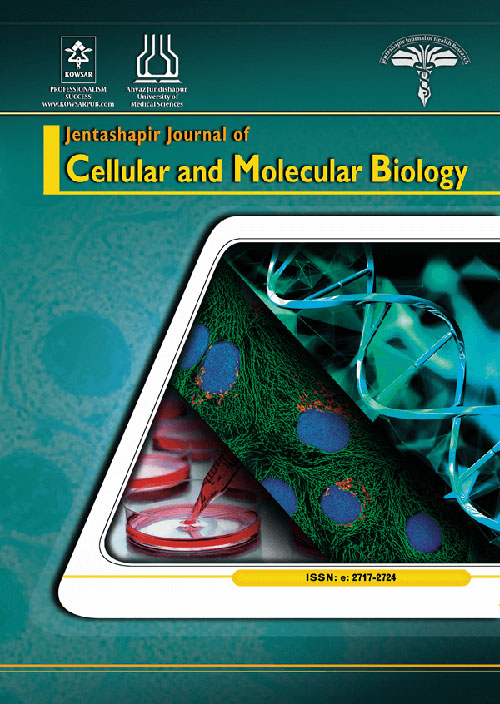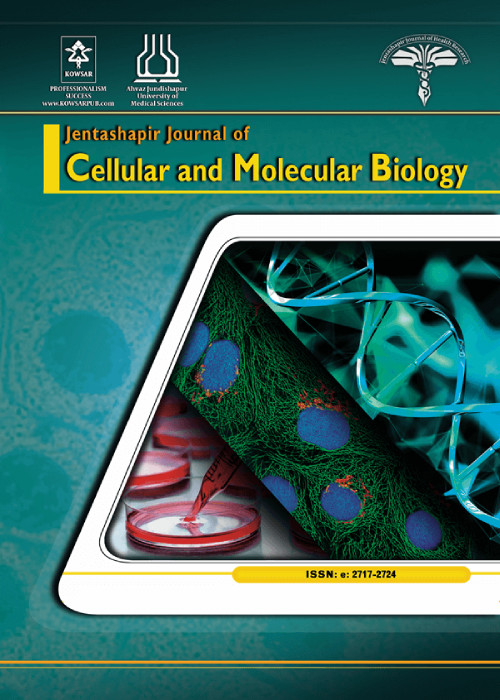فهرست مطالب

Jentashapir Journal of Cellular and Molecular Biology
Volume:12 Issue: 4, Dec 2021
- تاریخ انتشار: 1400/10/05
- تعداد عناوین: 8
-
-
Page 1Backgrounds
Molecular mechanisms involved in adverse effects of morphine, including tolerance and dependence, have remained elusive. We examined possible alterations in the gene expression of proenkephalin (Penk), prodynorphin (Pdyn), and muopioid receptor (Oprm1) in reward brain areas following frequent morphine treatment.
MethodsTwo groups of male Wistar rats were used. The groups received either saline (1 mL/kg) or morphine (10 mg/kg) twice daily for eight days. On day 8, rats were decapitated, brain areas involved in addiction were dissected, including the midbrain, striatum, prefrontal cortex (PFC), hippocampus, and hypothalamus, and gene expression was evaluated with real-time PCR.
ResultsProlonged morphine treatment decreased Penk, Pdyn, and Oprm1 gene expressions in the midbrain but upregulated them in the striatum compared to the control group treated with saline. Significant increases in Pdyn and Oprm1 gene expressions were detected in the PFC, but there was no significant difference in Penk gene expression between the two groups. Besides, Pdyn gene expression was decreased in the hippocampus and hypothalamus; however, no significant differences in Penk and Oprm1 gene expressions were detected between the groups in these areas.
ConclusionsThe expression of endogenous opioid peptides and receptors after frequent use of morphine follows a region specificity in brain areas involved in addiction. These alterations may result in new physiological setpoints outside the normal range, which need to be considered when using morphine in medicine.
Keywords: Substance Abuse, Drug Dependence, Gene Expression, Mesocorticolimbic System, Endogenous Opioid Peptides -
Cerebral Glioblastoma: A Review on Genetic Alterations, Signaling Pathways, and Clinical ManagementsPage 2Context
Glioblastoma, previously known as glioblastoma multiforme (GBM), is a grade IV astrocytoma that frequently affects patients with a mean age of 45 and above. It is generally categorized into primary and secondary subtypes, based on research conducted by Hans Joachim Scherer.
Evidence AcquisitionThis review concentrates on cellular and genetic drawbacks that can lead to the appearance of glioblastoma. National Center for Biotechnology Information (NCBI) was the main source used for writing this review article, followed by Google scholar. The following keywords were used to retrieve articles: ’glioblastoma’, ’brain tumors’, ’glioma’, ’LOH’, and ’cellular and signaling pathways in glioblastoma’.
ResultsSeveral genetic alterations and cellular pathways are involved in the appearance and progression of glioblastoma, including loss of heterozygosity (LoH), TP53 mutation, isocitrate dehydrogenase 1 (IDH1) mutation, P16INK4/RB1 pathway, and EGFR/PTEN/Akt/mTOR pathway. The majority (70%) of primary glioblastomas are caused by (LoH), and it mostly occurs in older people. Secondary glioblastoma is mainly manifested by TP53 mutation and usually affects younger people. Understanding the alterations and cellular mechanisms involved in glioblastoma is important to develope new therapeutic regimes. Surgery, radiation therapy, temozolomide, and TTFields are the four most important therapeutic options available for treating patients.
ConclusionsIn this review, the genetic alterations and cellular pathways which could lead to the appearance of this tumor were highlighted, and the latest options for treating patients dealing with glioblastoma were discussed.
Keywords: Glioblastoma, EGFR, LOH, RB1, P53, IDH1, TMZ -
Page 3
A growing global prevalence of acute kidney injury (AKI) and chronic kidney disease (CKD), high costs of kidney transplantation, a shortage of kidney donors, and low survival rate after dialysis have popularized mesenchymal stem cell (MSC) therapy via transplantation. However, the risks of tumorigenesis, immune rejection, pathogen transmission, loss of differentiation, and morphological changes after long-term culture have prompted researchers to develop a safer and more effective therapy method. Therefore, cellfree approaches have been developed to reduce the risks associated with stem cell-based therapies. In cell-free therapy of AKI and CKD, MSC-derived extracellular vesicles, with nanometer sizes, are used, called exosomes. Exosomes have a lipid bilayer membrane with various genes, microRNAs, and proteins for kidney repair. As known, MSC-derived exosomes have improved the kidney regeneration process for various reasons, such as increased safety and reduced inflammation, immune rejection, and tumorigenesis. With the advancement of exosome isolation techniques, the possibility of using biologically active molecules for renal injury prediction and diagnosis has emerged. The use of urinary exosomes in AKI and CKD diagnosis is based on changes in the expression of specific molecule cargos of exosomes. This review article summarizes the diagnosis and therapeutic applications of exosomes in AKI and CKD.
Keywords: MSC-derived Exosomes, Kidney Disease, Diagnosis, Therapy, Urinary Exosomes -
Page 4Background
Lung cancer is one of the most common leading causes of mortality and morbidity worldwide. Despite recent advances in therapeutic approaches, common methods are not fully effective. Thus, researchers are looking for some novel complementary agents to improve the effectiveness of therapies. Emerging evidence has shown the antitumor activity of several natural components such as quinoa seed extracts in various types of cancer.
ObjectivesHence, this study was conducted to evaluate the antiproliferation and anti-apoptotic activity of quinoa on the A549 lung cancer cell line.
MethodsThe cell viability of A549 cells treated with quinoa was detected using the 3-(4,5-dimethylthiazol-2-yl)-2,5- diphenyltetrazolium bromide (MTT) assay. The expression levels of BAX and BCL2 as apoptosis-related genes were assessed using real-time polymerase chain reaction (PCR). Finally, the statistical analysis was performed using GraphPad Prism version 7.
ResultsOur findings demonstrated that the cell viability decreased in a concentration and time-dependent manner. Also, treating A549 cells with doses of 1.60 and 1.92 mg/mL of quinoa seed extracts could increase BAX and decrease BCL2 expression levels (P < 0.05). However, the higher dose (1.92 mg/mL) was significantly effective.
ConclusionsAccording to this study, quinoa seed extract could induce apoptosis in lung cancer cells (A549) throughout the increased ratio of BAX/BCL2. However, further investigations are required to confirm the results.
Keywords: Quinoa, BAX, BCL2, Lung Cancer -
Page 5
HOX transcript antisense RNA (HOTAIR), as a long noncoding RNA (lncRNA) is a highly cited transcript modulating variety of signaling pathways such as cell growth and apoptosis. Altered expression of HOTAIR has been reported in human cancers, which contributes with cancer progression and metastasis. Increased expression level of HOTAIR has been observed in colorectal cancer (CRC). It seems that dysregulation of HOTAIR may inhibit the apoptosis. The present study was aimed to evaluate the effect of HOTAIR silencing on expression of apoptosis markers Bax and Bcl2 using real-time polymerase chain reaction (PCR). The data showed that HOTAIR and Bcl2 are highly expressed in CRC cells while the expression level of Bax is low. Following siRNA treatment, Blc2 was downregulated but Bcl2 was upregulated. These findings suggest that HOTAIR silencing can promote apoptosis, and thus it can be considered as a promising strategy to kill cancer cells.
Keywords: Colorectal Cancer, Apoptosis, Long Noncoding RNA, HOTAIR, Bax, Bcl2 -
Page 6Background
The growing population and limited agricultural land have pushed the demand for higher food production per land area. Edible mushrooms are a rich source of protein. Agaricus bisporus is the most common edible mushroom with high economic value. One of themost important steps in the production process of white buttonmushroom is the production of spawn. It is highly important to make pure high-quality mycelium during the production of spawn. Studies have shown that at this stage of production, a high level of morphological changes occurs in somemushrooms, which causes the formation of fluffy-shapedmycelium. This phenomenon is a kind of strain degeneration in edible mushrooms and is one of the biggest concerns of the producers of white button mushroom.
ObjectivesThe purpose of this study was to investigate the nature of stroma (strain degeneration) in white button mushroom, and to identify the causes of genetic changes.
MethodsIn this experiment, ten successive subcultures were produced from the mother mycelium on potato dextrose agar medium (pH: 6.2), and the genetic changes of mycelium were examined after ten successive subcultures. DNA extraction was performed after sampling of the mother, normal, and fluffy mycelia. Six pairs of designed primers and propagated parts were loaded into six polyacrylamide gels. DNA fragments were visualized using silver staining. Genetic comparisons were made between the mother, normal, and fluffy mycelia by the amplified fragment length polymorphism (AFLP) method, and the results were evaluated using POPGENE software.
ResultsThe AFLP marker produced 137 fragments for the H2 strain, of which 57 fragments had polymorphism between the mother, normal, and fluffy mycelia. For the 737 strain, 149 fragments were produced, of which 73 fragments had polymorphism between the mother, normal, and fluffy mycelia. On average, the mother, normal, and fluffy mycelia had about 42 and 49% polymorphism for the H2 and 737 strains, respectively. The degree of polymorphism among the samples confirmed genetic differences between the mother, normal, and fluffy mycelia.
ConclusionsBased on the results of the present study, we concluded that strain degeneration, which manifests as the fluffy mycelium of white button mushroom, has a genetic origin. These genetic differences can be attributed to diverse factors, such as the phenomenon of heterokaryosis, asexual recombination, and the formation of mitosis crossing over. These factors and their effects require further evaluations.
Keywords: AFLP, Agaricus bisporus, Heterokaryosis, Mitosis Crossing Over, Spawn, Strain Degeneration -
Page 7Background
Dental plaque is a microbial biofilm that can source various oral diseases.
ObjectivesThis study aimed to investigate the synergistic anti-biofilm effect of chlorhexidine (CHX) and propolis aqueous extract on Streptococcus mutans and Staphylococcus aureus.
MethodsThis study, performed on October 2021, determined the minimum biofilm inhibitory concentration (MBIC) and minimum biofilm eradication concentration (MBEC) of CHX 0.2% and propolis aqueous extract against S. mutans and S. aureus prepared from the cell bank of the Pasteur Institute of Iran. Also, the in vitro synergistic effect of these two compounds was evaluated on the biofilm inhibition and eradication of the studied bacteria using the checkerboard method.
ResultsThe MBIC of chlorhexidine was 125 µg/mL for both S. aureus and S. mutans, while the MBIC of propolis aqueous extract was 937.5 and 3750 µg/mL, respectively. Also, the MBEC of chlorhexidine was 250 and ≥ 500 µg/mL for S. aureus and S. mutans, while the MBEC of propolis was 1875 and≥ 7500 µg/mL, respectively. Combining the two substances showed a synergistic effect in inhibiting biofilm formation (P ≤ 0.05) but no significant difference in biofilm eradication.
ConclusionsThis study concluded that although CHX is one of the most common and vital oral disinfectants in oral diseases, propolis may also be used, as an alternative mouthwash with reliable natural antimicrobial properties, alone or combined with CHX as a moderator of its side effects.
Keywords: Biofilm, Chlorhexidine, MBEC, MBIC, Oral Pathogens, Propolis, Synergistic Effect -
Page 8Background
The paraoxonase1 gene (PON1) is part of the paraoxonase family of multifactorial antioxidants (EC 3.1.1.2). The functional single-nucleotide polymorphisms L55M and Q192R are located in the coding site of this gene. The association between these polymorphisms and breast cancer risk has been investigated, with contradictory results.
ObjectivesA meta-analysis was done to find the association betweenPON1(L55M andQ192R) gene polymorphisms and breast cancer risk.
MethodsWe searched Embase, Pubmed, and Web of Science for related articles. Twelve eligible studies before December 2021 were selected. Statistical analysis was done by STATA 14.0.
ResultWe summarized 12 studies of L55M and Q192R polymorphisms and breast cancer risk, involving 5,769 subjects (2,519 controls and 3,250 patients). In all genetic models, PON1-L55M polymorphisms were significantly associated with breast cancer risk. Besides, PON1-Q192R polymorphisms decreased breast cancer risk. The PON1-Q192R allele reduced the cancer risk, particularly breast cancer (OR (R vs. Q): 0.7932). However, an association was found between the PON1-L55M allele and increased breast cancer risk (OR (M vs. L): 1.6041).
DiscussionThe results of 11 out of 12 studies were consistent with our results. In a non-conforming study, this was probably due to errors in conducting experiments. Nonetheless, well-designed studies with more samples are needed to confirm our findings at protein levels.
Keywords: Polymorphism, Paraoxonase1, Q192R, L55M, Meta-Analysis, Breast Cancer


